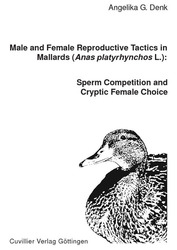| Fachbereiche | |
|---|---|
| Buchreihen (96) |
1378
|
| Nachhaltigkeit |
3
|
| Gesundheitswesen |
1
|
| Geisteswissenschaften |
2362
|
| Naturwissenschaften |
5406
|
| Mathematik | 229 |
| Informatik | 319 |
| Physik | 980 |
| Chemie | 1363 |
| Geowissenschaften | 131 |
| Humanmedizin | 243 |
| Zahn-, Mund- und Kieferheilkunde | 10 |
| Veterinärmedizin | 108 |
| Pharmazie | 147 |
| Biologie | 835 |
| Biochemie, Molekularbiologie, Gentechnologie | 121 |
| Biophysik | 25 |
| Ernährungs- und Haushaltswissenschaften | 45 |
| Land- und Agrarwissenschaften | 1004 |
| Forstwissenschaften | 201 |
| Gartenbauwissenschaft | 20 |
| Umweltforschung, Ökologie und Landespflege | 148 |
| Ingenieurwissenschaften |
1790
|
| Allgemein |
97
|
|
Leitlinien Unfallchirurgie
5. Auflage bestellen |
|
Erweiterte Suche
Male and Female Reproductive Tactics in Mallards (Anas Platyrhynchos L.): Sperm Competition and Cryptic Female Choice
Angelika G. Denk (Autor)Vorschau
Inhaltsverzeichnis, Datei (9,7 KB)
Leseprobe, Datei (120 KB)
This study examines male and female influence on reproductive success in mallards (Anas platyrhynchos).
Chapter One investigates three notable features of the breeding system in wild mallard populations (Lake Starnberg and Lake Ammer, Southern Germany) based on microsatellite analysis of 41 clutches. First, adult populations are male biased, although mallards form social monogamous pairs and unpaired males may suffer reduced reproductive success. We show that this male surplus is already prevalent at egg laying (60% males). Second, egg dumping is a common female strategy in waterfowl and increases reproductive output of parasitic females. We report on high levels of brood parasitism in a mallard population with high nesting density (53%) whereas no egg dumping was observed under low nesting density. Finally, forced extra-pair copulations are commonly pursued by drakes. We assess the level of extra-pair paternity (56% of broods containing extra-pair young), which so far is the highest reported in waterfowl. However extra-pair fertilization was lower than expected from rates of extra-pair copulations described in literature.
Chapter Two experimentally examines the relevance of postcopulatory female control of male fertilization success in comparison to sperm competition. By artificially inseminating groups of four sisters with a sperm mixture containing equal sperm numbers of one brother and one unrelated male we did not observe any effect of parental relatedness on gain of paternity. However male reproductive success was significantly influenced by long-term sperm performance (sperm motility, sperm swimming speed).
Chapter Three investigates whether the female environment differentially influences sperm activity (concentration of motile sperm, sperm swimming speed). To test sperm activity in different female environment we measured sperm swimming in buffer and added female blood plasma. Again no effect of genetic relatedness was observed, but female reproductive status significantly influenced the amount of motile sperm and sperm swimming speed. Furthermore we observed a strong individual female effect on sperm activity.
Chapter Four discusses the relationship between frequent copulations and ejaculate quality (sperm concentration, sperm swimming speed). After males were prevented to copulate with their social partner, sperm concentration and sperm velocity increased significantly. Therefore number of copulations trade against competitiveness of single ejaculates.
Chapter Five describes the positive relationship of testis size and circulating levels of testosterone in mallard drakes during the reproductive season.
| ISBN-13 (Printausgabe) | 3865375081 |
| ISBN-13 (Printausgabe) | 9783865375087 |
| ISBN-13 (E-Book) | 9783736915084 |
| Sprache | Deutsch |
| Seitenanzahl | 176 |
| Auflage | 1 Aufl. |
| Band | 0 |
| Erscheinungsort | Göttingen |
| Promotionsort | München |
| Erscheinungsdatum | 18.07.2005 |
| Allgemeine Einordnung | Dissertation |
| Fachbereiche |
Biologie
|








